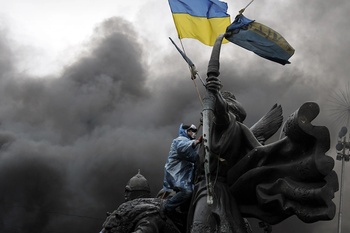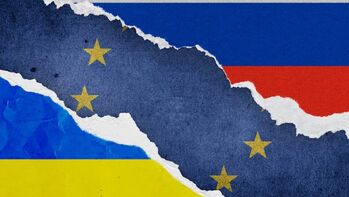Osman Softić || 17 March 2025
 US President Donald Trump, his unconventional maverick personality notwithstanding, and his rather peculiar undiplomatic ways of conducting statecraft that markedly deviated from conventional norms and even logic itself, (especially due to his disturbing rhetoric regarding Canada, Greenland, Mexico, Panama and Gaza), when it comes to great power politics, it ought to be admitted, seems to be much more serious especially when it comes to Trump’s commitment to put an end to the tragic armed conflict in Ukraine. Nevertheless, he is working with Kremlin towards brokering a viable and lasting peace agreement between Ukraine and Russia, in opposition to Ukraine and the EU which both disagree with Trump at least with respect to the proposed terms of the peace agreement, which analysts claim, were made known to Trump by the Russians and are acceptable to him.
US President Donald Trump, his unconventional maverick personality notwithstanding, and his rather peculiar undiplomatic ways of conducting statecraft that markedly deviated from conventional norms and even logic itself, (especially due to his disturbing rhetoric regarding Canada, Greenland, Mexico, Panama and Gaza), when it comes to great power politics, it ought to be admitted, seems to be much more serious especially when it comes to Trump’s commitment to put an end to the tragic armed conflict in Ukraine. Nevertheless, he is working with Kremlin towards brokering a viable and lasting peace agreement between Ukraine and Russia, in opposition to Ukraine and the EU which both disagree with Trump at least with respect to the proposed terms of the peace agreement, which analysts claim, were made known to Trump by the Russians and are acceptable to him.
The US president wants swift normalization of relations between Washington and Moscow and is open to a serious dialogue with Vladimir Putin on establishing a new security architecture in Europe. The Russian administration in the Kremlin has been waiting for a real opportunity and receptiveness to engage in a serious dialogue on this globally important issue of peace and security for almost two decades now, ever since Vladimir Putin came to power in Russia. The Russian leader and his officials and diplomats have repeatedly emphasized this in various international forums but they have been systematically ignored on this issue by all American administrations and the Washington liberal establishment as well as by European administrations in Brussels.
The Neocons
Germany, truth be told, had always displayed a somewhat milder and more pragmatic attitude toward Russia, especially under Angela Merkel. But, as we have recently found out, even the former German conservative chancellor Merkel, whom Putin apparently trusted, had also been as a diplomatic charade and a tool for buying more time so that Europe and America could better arm and train the Ukrainian army to enable it to execute the war against pro-Russian separatist rebels in the east more competently. Many people fail to understand that the Ukrainian conflict had been going on albeit at low intensity since 2014. and it only intensified in February 2022 when Russia invaded Ukraine. The war in Ukraine has its many complicated causes that observers will never be able to agree on because of their irreconcilable ideological positions.

Trump and his new administration and advisers are aware that policies of the previous US administrations towards Russia – best symbolized from the very beginning by coup de état in Kiev which overthrew democratically elected but pro-Russian leaning former president of Ukraine Viktor Yanukovich that was orchestrated by the Obama administration in 2014, largely dominated by American anti Russia neoconservative hawks with background from either Eastern Europe, Ukraine and Russia, under the stewardship of Victoria Nuland, had not achieved the expected objectives. Such policies were proven to be wrong and harmful to American long-term strategic interests and also went against European interests of peace, stability and prosperity. These policies contributed to the destruction of Ukraine, as John Mearsheimer of Chicago University repeatedly stated a decade ago that US administrations of Barack Obama and Joseph Biden wholeheartedly embraced by European administrations in Brussels were leading Ukraine along the “primrose path” whereby Ukraine will be wrecked and made a dysfunctional rump state causing tremendous loss of human lives on both sides. Some analysts estimate that 900 thousand soldiers have been killed and wounded on the Russian side alone in the past three years. Losses on the Ukrainian side are probably even greater, especially among civilians. But the Ukrainian regime of Volodimir Zelenskyy is hiding data on the real number of victims, as Russia probably does too, for well-known reasons.
Trump is cognizant of the fact that if he allows failed policies to continue unchallenged (unconditional military support to Ukraine in the proxy war between the collective West and Russia), this could well push Moscow irreversibly into Beijing’s embrace thus allowing strategic relations between the two Asian behemoths to be cemented beyond repair and in the process strengthen their common antagonism against the United States. The continuation of the neocon anti-Russian agenda in Ukraine would allow Russia and China – great powers that had never been closer to each other in history than they are today – to form even closer strategic ties against the west. Moreover, they were adversaries or at least rivals during the time of Soviet communism and they fought bitter wars for territory.
The “Kissingerian” approach
Trump has decided to try a different, one could argue a “Kissingerian” approach. He is therefore determined to do away with bankrupt neoconservative irrational anti Russia policies and is eager to make a rapprochement with Putin to try and remove the incentive for Russia to consolidate its joint positioning with China for the control over the Eurasian landmass, an enormously strategic territory which British geographer and geopolitical scholar Halford Mackinder called “Heartland”. Hitler’s paramount geopolitical strategist Karl Haushofer had borrowed Mackinder’s agenda and used it as the key rationale for the Wehrmacht’s invasion of Russia during World War II – Policy known as Ost politics.
 Donald Trump and his foreign policy heavyweights are aware that the strategic positioning of Russia and China on the Eurasian heartland, with all the Belt and Road initiatives and corresponding transportation and energy corridors through central Asia, including International North-South Corridor (INSTC) which Russia is trying to finalize with Iran and India, would be further strengthened by the inclusion of Iran in tripartite alliance should it ever be formally established. So far, the troika has only entered into a strategic partnership but not an iron clad defensive alliance of the NATO type.
Donald Trump and his foreign policy heavyweights are aware that the strategic positioning of Russia and China on the Eurasian heartland, with all the Belt and Road initiatives and corresponding transportation and energy corridors through central Asia, including International North-South Corridor (INSTC) which Russia is trying to finalize with Iran and India, would be further strengthened by the inclusion of Iran in tripartite alliance should it ever be formally established. So far, the troika has only entered into a strategic partnership but not an iron clad defensive alliance of the NATO type.
Iran’s entry into a strategic partnership with China and Russia is no secret, but it is important to differentiate it from the military alliance which it is not. A few years ago, Iran signed a 25-year strategic agreement with China that envisaged large Chinese investments in Iran in the tens of billions of dollars, while Iran would supply China with oil and gas in return. There are also secret clauses in the agreement that probably relate to cooperation between the two countries in the field of defense and security, exchange of technologies, etc. Just before President Trump’s inauguration, Iranian President Masoud Pezeshkian went to Moscow where he signed an agreement on strategic relations between Iran and Russia with Vladimir Putin. This was not only a symbolic gesture but it also had real significance although this agreement should not be overestimated, because it does not contain any obligation of mutual military defense. It only guarantees that in the event of a war between either of the two countries with a third party, the country signing the agreement will not support the aggressor. However, the aforementioned agreement allows for the exchange of technologies and defense cooperation between Moscow and Tehran.
Iran, whose air force is inferior to its regional rivals in the Middle East, due to economic sanctions imposed on Iran that have lasted for four decades, hopes to acquire modern fourth-generation Sukhoi 35 fighter jets from Moscow, and even the fifth-generation crafts, which would allow Iran to compete with its neighbors especially Israel its major regional adversary, in the foreseeable future. Due to the shortcomings of its air force Iran has developed an asymmetric defense doctrine based on cultivating a network of allies across the West Asia (non-state actors known as the axis of resistance), sophisticated drones in the production of which Iran is a world leader, and especially short and medium-range ballistic missiles, which are considered to be offensive weapons with an operational radius of maximum 2,000 kilometers, since the Iranian defense doctrine is based on the principle that offensive capability is the best form of defense.
Therefore, further prolongation of the war in Ukraine and the American focus on that battlefield from the perspective of the new rulers in Washington, would significantly reduce Washington’s chances of securing its influence on the Eurasian continent since the epicenter of political, economic, and technological power is rapidly shifting from the West (from Europe) to East Asia.
Hypocrisy of the Europeans
 Leaders of the vast majority of the European Union member states want the war in Ukraine to continue. They believe that Ukraine can defeat Russia and recapture its occupied and annexed territories by military force alone. Some of them, as exemplified recently by the UK prime minister Keir Starmer’s statement, stubbornly cling to the promise made earlier that Ukraine should become a member of NATO. EU countries see the continuation of the war and military support for Ukraine as the only way forward. They also see their such position as the ideological glue and foundation of shared ideological identity that is still holding Europe together, at least for now. They almost seem to elevate the Ukrainian President Volodymyr Zelenskyy to such a pedestal that they glorify while they consider Russian president Vladimir Putin to be an embodiment of evil, a new Hitler, autocrat, imperialist, war criminal and what not.
Leaders of the vast majority of the European Union member states want the war in Ukraine to continue. They believe that Ukraine can defeat Russia and recapture its occupied and annexed territories by military force alone. Some of them, as exemplified recently by the UK prime minister Keir Starmer’s statement, stubbornly cling to the promise made earlier that Ukraine should become a member of NATO. EU countries see the continuation of the war and military support for Ukraine as the only way forward. They also see their such position as the ideological glue and foundation of shared ideological identity that is still holding Europe together, at least for now. They almost seem to elevate the Ukrainian President Volodymyr Zelenskyy to such a pedestal that they glorify while they consider Russian president Vladimir Putin to be an embodiment of evil, a new Hitler, autocrat, imperialist, war criminal and what not.
At the same time, European elites hypocritically maintain economic relations and trade with Russia despite the sanctions that both Washington and Brussels have imposed on Moscow. Hypocrisy of the European politicians and especially its unelected top bureaucrats in Brussels, who are often criticized for increasingly becoming alienated from their peoples, is further reflected in the fact that Europe throughout the conflict in Ukraine since 2014 has been horrified at any thought that a path to peaceful resolution of the conflict at the negotiating table should be actively pursued despite the fact that such attitude could trigger a global conflict with fatal consequences and even provoke a nuclear war on the European soil. However, they want the US to take the lion share of that burden.
Trump is aware of the catastrophic failure of the policy of NATO expansion and spreading liberal hegemony eastward at any cost, policy Washington had been pursuing until recently, in an effort to expand the influence of NATO alliance in Ukraine in order to surround and contain Russia in line with the policy that US applied during the cold war with the former Soviet Union. Joe Biden used to claim that American policies and financial sanctions have halved Russia’s economy in the belief that they would cause the collapse of Russia and lead to a ‘regime change’ in Moscow. This did not happen. Some of the most respectable American experts and theorists of international relations have been pointing out the perniciousness of this policy for years. The most energetic in this regard is professor John Mearsheimer, and as of recently, for the first time, professor Jeffrey Sachs, a vocal critic of American hegemonic policy towards Russia and China and a critic of European policy that follows Washington in everything, has recently spoken on the subject in the European Parliament.
Pivot to Asia
Given that Trump sees China as Washington’s main rival for global primacy he therefore wants to redirect the focus of American strategic policy and move the American military resources to East Asia and more broadly to the Indo-Pacific region. This doctrine dates back to 2013 when Hillary Clinton, former Secretary of State, first announced Washington’s commitment to make a “pivot to Asia”. Trump therefore wants to stop the war in Ukraine as soon as possible. He wants to free up American resources in Europe. He wants to establish rapprochement with Moscow. Furthermore, as Trump would want to be remembered as a man of peace, he would ideally want to end armed conflicts in the Middle East as well.
In West Asia, America, according to serious scholars such as Mearsheimer, no longer has vital national interests to protect, which would make the US permanent military presence on a large scale in that region necessary. However, the withdrawal of American troops from the Middle East will be easier said than done, and will be much more difficult, because Israel, whose powerful lobby in the United States has a huge influence on the US Congress and the administration, will do all it can to prevent that from happening. Israel will try to drag Washington into a war with Iran on its behalf, because the Israeli regime does not have the capacity to neutralize Iran on its own. Iran has consistently maintained that its nuclear program is for peaceful purposes (medical research, clean energy etc.) and has no intention of producing atomic weapons, while its enrichment of uranium strategy is only a leverage Iran uses as a deterrent after Trump withdrew the US from the JCPOA in 2018.
Nevertheless, Israel is adamant that Iran is pursuing nuclear weapons and that it came close to accomplishing it as it now not only musters technology of high enrichment of uranium but it also has technological wherewithal to reprocess plutonium and to weaponize the enriched uranium to produce fissile material to make a bomb. In fact, Israeli leadership consider Iran to be the only serious obstacle in the region which stands in the way of Israel’s path to establishing regional hegemony in West Asia. which Israel gloats in its self-proclaimed image of being perceived as a mini super power in the region that possesses superior military technology. Its air force is superior to any of its neighbors. Israel is believed to possess between 90 and 200 nuclear warheads deployed for launching from land, air and under the sea (from submarines). Israel is not a signatory to the NPT treaty and has never been the subject of an investigation by the International Atomic Energy Agency (IAEA).
 Osman Softić is a Research Fellow at the Islamic Renaissance Front. He holds a BA degree in Islamic Studies from the Faculty of Islamic Studies of the University of Sarajevo and has a Master degree in International Relations from the University of New South Wales (UNSW). He contributed commentaries on Middle Eastern and Islamic Affairs for the web portal Al Jazeera Balkans, Online Opinion, Engage and Open Democracy. Osman holds dual Bosnian and Australian citizenship.
Osman Softić is a Research Fellow at the Islamic Renaissance Front. He holds a BA degree in Islamic Studies from the Faculty of Islamic Studies of the University of Sarajevo and has a Master degree in International Relations from the University of New South Wales (UNSW). He contributed commentaries on Middle Eastern and Islamic Affairs for the web portal Al Jazeera Balkans, Online Opinion, Engage and Open Democracy. Osman holds dual Bosnian and Australian citizenship.

